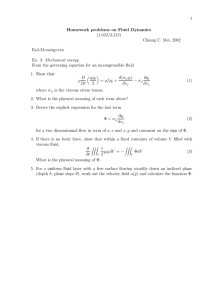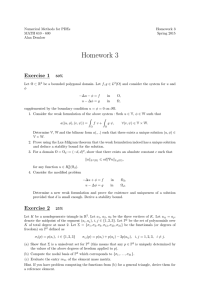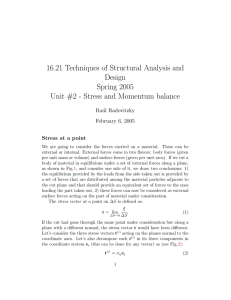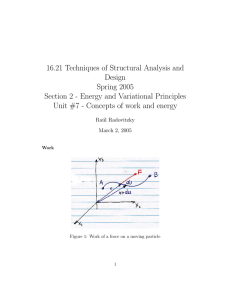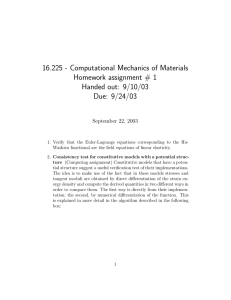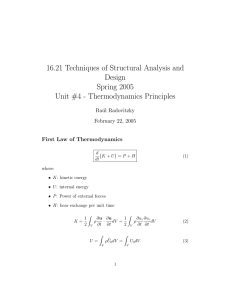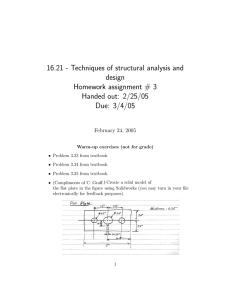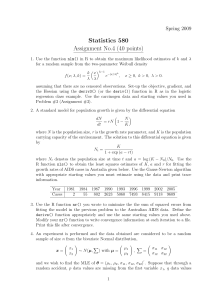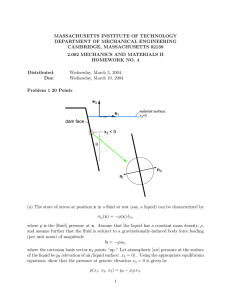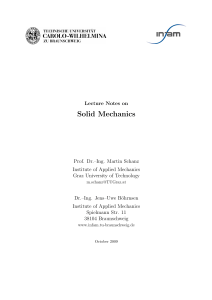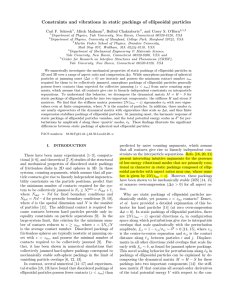1.4 Forces in the Fluid
advertisement
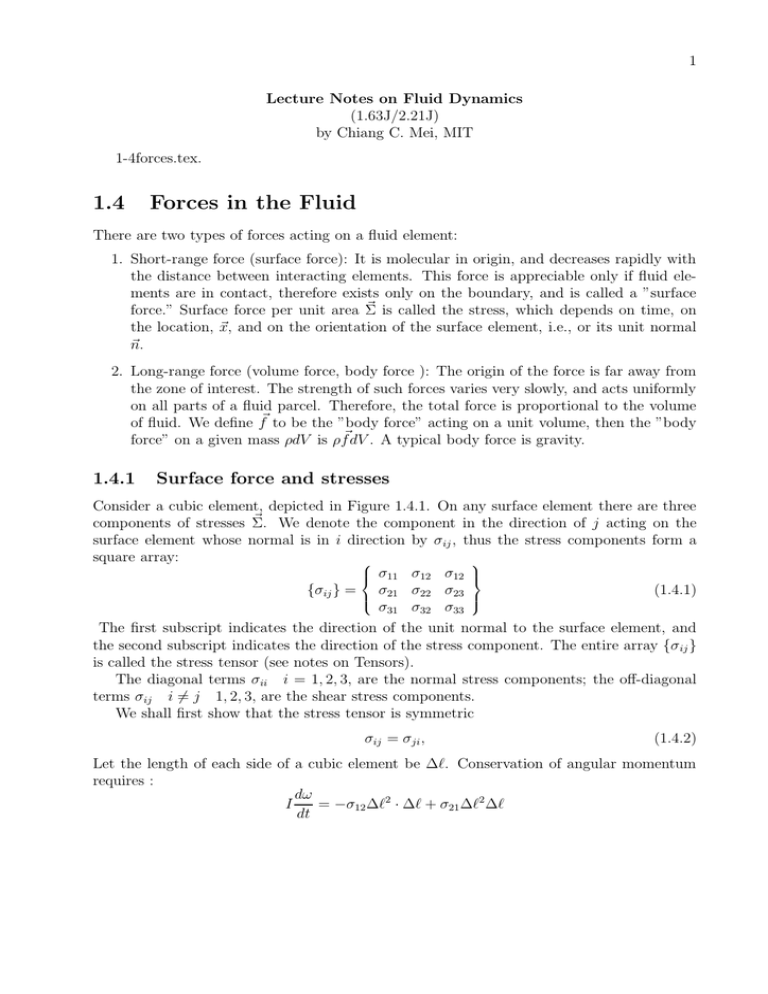
1
Lecture Notes on Fluid Dynamics
(1.63J/2.21J)
by Chiang C. Mei, MIT
1-4forces.tex.
1.4
Forces in the Fluid
There are two types of forces acting on a fluid element:
1. Short-range force (surface force): It is molecular in origin, and decreases rapidly with
the distance between interacting elements. This force is appreciable only if fluid elements are in contact, therefore exists only on the boundary, and is called a ”surface
~ is called the stress, which depends on time, on
force.” Surface force per unit area Σ
the location, ~x, and on the orientation of the surface element, i.e., or its unit normal
~n.
2. Long-range force (volume force, body force ): The origin of the force is far away from
the zone of interest. The strength of such forces varies very slowly, and acts uniformly
on all parts of a fluid parcel. Therefore, the total force is proportional to the volume
of fluid. We define f~ to be the ”body force” acting on a unit volume, then the ”body
force” on a given mass ρdV is ρf~dV . A typical body force is gravity.
1.4.1
Surface force and stresses
Consider a cubic element, depicted in Figure 1.4.1. On any surface element there are three
~ We denote the component in the direction of j acting on the
components of stresses Σ.
surface element whose normal is in i direction by σij , thus the stress components form a
square array:
σ11 σ12 σ12
{σij } = σ21 σ22 σ23
(1.4.1)
σ31 σ32 σ33
The first subscript indicates the direction of the unit normal to the surface element, and
the second subscript indicates the direction of the stress component. The entire array {σij }
is called the stress tensor (see notes on Tensors).
The diagonal terms σii i = 1, 2, 3, are the normal stress components; the off-diagonal
terms σij i 6= j 1, 2, 3, are the shear stress components.
We shall first show that the stress tensor is symmetric
σij = σji ,
(1.4.2)
Let the length of each side of a cubic element be ∆`. Conservation of angular momentum
requires :
dω
I
= −σ12 ∆`2 · ∆` + σ21 ∆`2 ∆`
dt
2
Figure 1.4.1: Stress components on a fluid element
From left to right, the terms represent, respectively, the angular inertia, the torque due
to shear stress on the two vertical surfaces and the torque due to shear on two horizontal
surfaces. Now the moment of inertia I ∝ ρ(∆`)5 . Hence, as ∆` → 0, σ12 = σ21 as long as
dω/dt 6= ∞. After similar arguments for all other off-diagonal components, we prove (1.4.2).
Thus among nine components, only six can be distinct.
1.4.2
Cauchy’s theorem
Are σij , defined on three mutually orthogonal surfaces in a chosen coordinate system, capable of describing stresses on any surface? In other words, can the stress components
on any surface be expressed in terms of σij ? To answer this question let us consider a
tetrahedron shown in Figure 1.4.2. Three sides are formed by orthogonal surface elements
dS1 = BCO, dS2 = ACO, dS3 = ABO whose unit normals are −~e1 , −~e2 , −~e3 , respectively.
The fourth side dS = ABC is inclined with the unit normal ~n = (n1 , n2 , n3 ) pointing in an
arbitrary direction.
First, let’s show that
dS1 = n1 dS = cos (~n, ~e1 ) dS
dS2 = n2 dS = cos (~n, ~e2 ) dS
dS3 = n3 dS = cos (~n, ~e3 ) dS
In other words
dSi = ni dS,
i = 1, 2, 3.
(1.4.3)
3
Figure 1.4.2: Stress components on any surface element
~ By Gauss’ theorem
Consider an arbitrary constant vector A.
ZZZ
~
∇ · AdS
=
V
ZZ
~ · ~ndS,
A
S
~ is
where V is the volume of the tetrahedron and S the total surface of tetrahedron. Since A
~
a constant vector, ∇ · A = 0.
0=
ZZ
~ · ~ndS = A
~·
A
S
ZZ
~ndS = 0.
S
~ is arbitrary
Since A
ZZ
S
~ndS = 0 = ~ndS − ~e1 dS1 − ~e2 dS2 − ~e3 dS3 .
Hence
~n · ~e1 dS = n1 dS = dS1
~n · ~e2 dS = n2 dS = dS2
~n · ~e3 dS = n3 dS = dS3
4
Note that the volume of the tetrahedron is 13 hdS where h is the vertical distance from the
origin to the surface dS.
Next we consider the force balance in the x1 direction, i.e., Fx = max :
h
h dq1
−σ11 n1 dS − σ21 n2 dS − σ31 n3 dS + Σ1 dS + ρfx dS = ρ dS
.
3
3
dt
(1.4.4)
where fx is the x component of the body force per unit volume. As the tetrahedron shrinks
to a point h → 0, the last two terms diminish much faster than the rest by a factor h for
any finite fi and dq1 /dt, i = 1, 2, 3, hence,
Σ1 = σ11 n1 + σ21 n2 + σ31 n3
= σ11 n1 + σ12 n2 + σ13 n3
= σ1j nj .
(σ21 = σ12 )
Similar results are obtained by considering the force balance in two other directions. In
summary, we have
Σi = σij nj
(1.4.5)
~ on a surface element of any orientation is a linear superposition
which states that the stress Σ
of the stress components defined on a cube in some Cartesian coordinate system. This result
is called Cauchy’s formula.
Note that Σi is tensor of rank 1 and ~n = {nj } is an arbitrary tensor of rank 1 (because
the surface dS is arbitrary). Equation (1.4.5) states that the scalar product of the array of
numbers σij with an arbitrary tensor nj of rank 1 is another tensor Σi of rank 1. By the
quotient law the array {σij } must be a tensor of rank two.
